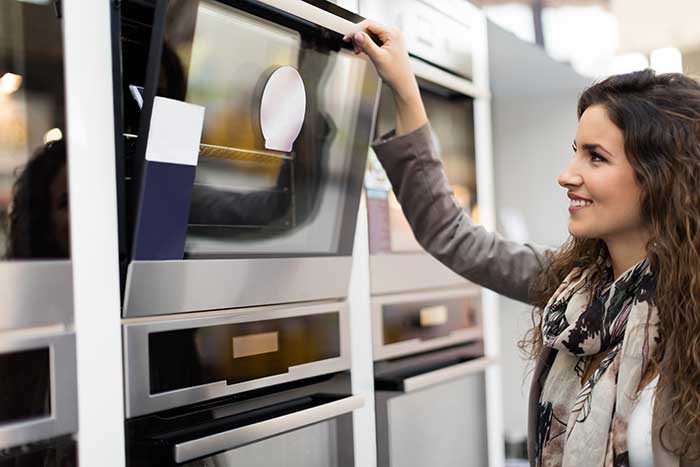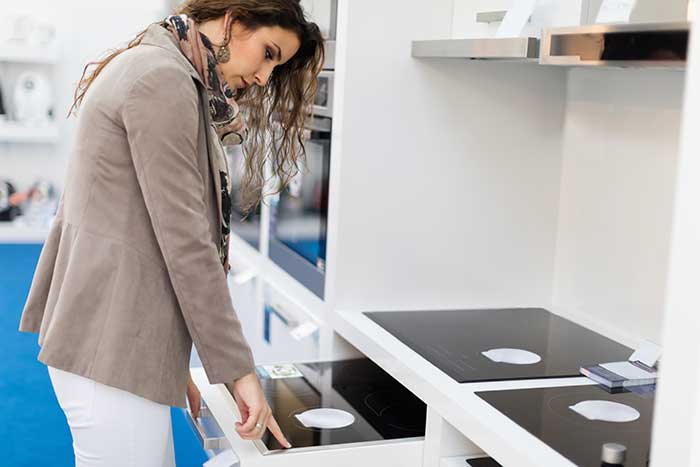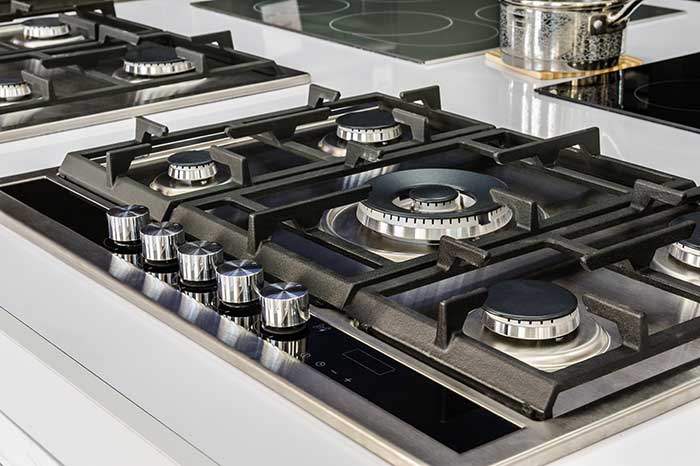Ovens, Stoves, Cooktops
General Information
Wow — there are a lot of choices when it comes to how you’ll bake and simmer your dinner. You can have your cooktop and oven in the form of one appliance (a range) or separated at different locations in your kitchen. And each situation involves a myriad of choices including options of sizes, styles, fuel sources, energy consumption, heating methods and features. If the sheer number of choices available hasn’t already made you think you need some professional help, keep in mind that the consequences of incorrectly choosing or installing these appliances can be expensive and dangerous. This is one appliance area that you should definitely seek the advice and assistance of true experts. Make sure you find a store that specializes in appliances to help you shop for your new oven, stove, or range.

Ovens
Ovens can be part of a range or stand alone as a separate appliance. Though this section mostly addresses ovens as separate appliances, many of the same features and choices are available in ovens that are part of a range as well.
There exist three main choices when it comes to ovens: the size, cleaning method and heating method. Read about the choices available and their pros and cons.
Plan ahead
The first decision you need to make is what form you want these appliances to take. Do you want them together in one central location? Do you want the oven and stove separated? How will these appliances fit in with the architecture of your kitchen? There are three distinct options for this most basic question.
Ovens: Technically, an oven is a large cavity with a door that is used for baking and broiling food. Your oven can be part of a range, or can be separated and built into a wall or cabinet space.
Stoves: Stoves have four or more burners on which pots are placed to cook food in. Stoves can be part of your range or can be built into your kitchen separately on a countertop or even in a kitchen island.
Ranges: Ranges are a single appliance unit that combines both an oven and a stove. These are the most traditional forms of ovens/stoves.
Read about the type of appliance you are thinking about purchasing for more information about the many varieties available, their pros and cons and helpful tips to choosing the correct model for you and your family. Expect to be overwhelmed; there are a variety of options in styles, sizes, features and fuel sources. Feel free to contact the experts at Ralph’s Electric for more assistance as you shop for your new oven, stove, or range.
Size
Ovens come in three main sizes: single, double and combination. Consider the following questions. How many people like to cook at the same time in your home? How often do you entertain large numbers of guests? And do you or your family members have any physical limitations that make opening the oven or taking pans in and out of the oven difficult?
Single ovens are the most traditional model of ovens. They have one door which almost always hinges at the bottom of the oven opening from the top down. Single ovens are great for those that have limited space in their kitchens. However, only one temperature is available at a time, meaning longer cooking times if multiple items must be baked at different temperatures.
Double ovens have two separate cavities. Each cavity can be heated to any temperature independent of the other, allowing cooks to bake food at different temperatures simultaneously. They take up more space than a single oven, but are great for prolific cooks.
Combination ovens are a single or double oven combined with a microwave installed on top of the oven. This provides a very sleek kitchen design with all these appliances in one central location. These units are usually quite large and usually require a custom space in the kitchen cabinetry.
Cleaning Method
Nobody likes to clean their appliances and it’s even worse to spend time thinking about cleaning them in the future! But you owe it to yourself to consider your future cleaning when picking out a new oven. You can choose between standard cleaning, self cleaning and continuous cleaning ovens.
Standard Cleaning ovens must be cleaned by hand with soap and water. Some models have removable doors to make cleaning hard to reach spaces easier. This cleaning method is usually the most inexpensive option of the three methods available.
Self Cleaning ovens use an extremely high heat cycle to turn soil inside your oven into a fine powder that can be easily wiped away with a damp cloth. Self Cleaning ovens are very fast and easy to clean and require very little of your own effort. They have special safety precautions that lock the door when the high heat cleaning cycle is in use. This added convenience usually adds to the price as well, especially since special porcelain enamels and door seals are required for safety purposes.
Continuous Cleaning ovens also get rid of oven soil without your elbow grease, but these models do not require the extreme heat cycle. Instead, the walls are treated with a special catalyst that oxidizes the soil continuously. Because the extreme high heat cycle isn’t needed, these units consume less energy which reduces the cost of their operation. However, most people find that these models do not clean the ovens quite as well as Self Cleaning models and still require some scrubbing at times.
Heating Method
Ovens can be further classified by their heating method into one of two types: conventional ovens or convection ovens. Below is a description of each type of heating method and their relative pros and cons. It’s important to ask yourself how vital cooking quality and price are in your decision, as well as what power sources you have available.
Conventional ovens are, well, the conventional type! These ovens have two heating elements; one for baking and roasting and another for broiling foods. Most people use their oven primarily to bake items, during which heat comes from the bottom of the oven. Some more modern conventional ovens will have heating systems which use both upper and lower heating elements during baking, which can amount to a more even heating of the food. Conventional ovens are usually the less expensive option of heating methods available, but some cooks notice they do not always heat food evenly.
Convection ovens all have an extra critical component that separates them from conventional ovens: a fan. The fan helps to disperse the hot air faster and more evenly throughout the cooking space. This helps food to cook more evenly throughout and also uses about 50% less energy than conventional ovens. Because the hot air will circulate faster, convection ovens reduce cooking times by an average of 30%.
As if there were not enough choices already, there exist two types of convection ovens. Fan assisted convection ovens disperse heat from the bottom and the fan is located at the rear. Fan forced convection ovens have the fan surrounded by the heating element. This allows the food to be placed anywhere in the entire oven. Keep in mind that fan assisted units come in both electric and gas compatible models, while fan forced is only found in electric units. Fan forced units are usually louder and can make food dry out faster if it is not covered properly.

Stove Tops
Stove tops get a lot of attention and inspire a lot of debate between cooking professionals and average kitchen owners alike. Stove tops can be part of range or stand alone as their own independent appliance. There are a variety of fuel choices, each with their own unique pros and cons. And don’t forget to consider all the new technology that has added features to more traditional models and also created entirely new heating methods. Read about the stove tops listed below to learn more about them.

Standard Gas Burners
The standard gas burners are the most traditional and common choice for professional cooks. Because the burner and pot/pan is heated directly by an open flame, it is very easy to control the temperature very precisely and most importantly, immediately. Professional chefs require the ability to raise or lower the temperature of the burner immediately upon adjusting the knob. If you’re a cooking enthusiast, you probably already know the great benefits of cooking on a standard gas burner stove-top and would love to get your hands on one.
Though standard gas burners have many highly sought after features, there are also some drawbacks in certain circumstances to having this kind of stovetop. Since this type of stove top uses gas as its fuel source, a properly installed gas line and hookup in your kitchen is required. If that does not already exist, getting one installed can be pricey. Also, the flame is visible in these models and therefore could be dangerous, especially if small children have access to that area. Energy efficiency varies and depends on the local costs of electricity verses gas in your area. Also, check into standard gas burners that have pilot-less ignitions to conserve energy.
Electric Coil Elements
Stove tops with electric coil elements are fueled by electricity rather than gas. There are several advantages to using this kind of stove top. They are usually less expensive than gas models. They are also safer because there are no visible flames. They do not require a gas hookup, which can be expensive to install if one does not already exist. They are also very easy to maintain and inexpensive to repair.
Though stove tops with electric coil elements can be less expensive than gas models at their initial purchase, they can cost you more over time in most areas of the country. Check into the relative cost of electricity and gas in your local area. Also, heating and cooling these burners takes longer, meaning you have less immediate control over the temperature you are cooking with. In general, electric coil elements are less responsive than gas, making most professional chefs prefer to have the increased control allowed by gas burners.
Ceramic Glass Burners
Stove tops with ceramic glass burners have increased in popularity lately. They offer a smooth surface that is very easy to clean and is very visually appealing. When the stove top is not in use, the top can be used as extra counter space. No crumbs or spills can get into the burners which not only makes this unit easy to clean, but also reduces the chance of little kitchen flare ups.
Because ceramic glass burner stove tops are fueled with electricity, they are not as precise and responsive as gas stove tops. It is sometimes difficult to tell if the burners are still hot after turning them off, which could be a safety issue, especially if small children have access to that area. Because of the upgraded flat smooth cooking surface, ceramic glass burners can be more expensive than standard electric coil burners.
Magnetic Induction
Magnetic induction stove tops are relatively new on the market and many people have never heard of them. They are very similar in appearance to stovetops with ceramic glass burners. They both offer smooth surfaces that are easy to clean and are very attractive. However, that is where the similarities end between these two types of stove tops.
Magnetic induction stove tops only work with steel and cast iron pans (or any pan that you can get a magnet to stick to). Because they only cause the pan and its contents to heat up, the rest of the surface unit remains completely cool at all times. Because of this, these stove top units are very safe. They are also extremely responsive and precise, making them very similar to cooking with gas stove top units but without the need for a gas line and hookup in your kitchen.
Like most new technologies, magnetic induction stoves come with a premium price and are usually more expensive than other types of stove tops. Also, make sure to consider whether or not the pots and pans you currently own will work with this type of appliance. If you’re looking for the accuracy and performance of a gas stove top, but more safety and no need for a separate gas line and hookup, look into magnetic induction stove tops.
Solid Disks
These stove tops are very similar to electric coil stove tops. Instead of open coils, they have solid cast iron disks in which the burner elements are contained. This makes them very easy to clean and also unique and attractive. The extra ease of cleaning and unique look come at a price though; the solid cast iron disks are very slow to heat up and cool down, which can lengthen cooking time and decreases the control you have over temperature.
Ranges
Many people choose to have their oven and stove come together in one convenient appliance; the range. Though choosing a range eliminates the need to choose two places in your kitchen for a separate stove top and oven, there are a myriad of other choices available to you when choosing which range is right for you.
The two main choices you will have to make involve your fuel choice and how it will be installed in your kitchen. Read about the different fuel choices available in ranges and their relative pros and cons.
Fuel choices
When buying a range, it is important to consider what fuel source you wish to use. There are three main choices in ranges available: electric ranges, gas ranges and dual fuel gas and electric ranges.
Electric ranges are by far the most popular choice today. In most homes, electricity is more available for kitchen appliances than gas is. The coils in the stove top are reliable and very easy and inexpensive to replace should they fail. Almost all cookware can be used in these ranges and they are often safer since there is no open flame. Some gas stove tops may not be able to heat consistently at very low temperatures, though electric stove tops usually do this with ease.
Ranges with open electric coils on the stove top can be vulnerable to spills. Smooth closed tops are available and usually come with a bigger price tag. The responsiveness and precision of stove top heating is not as fine as with gas units. Though most professional cooks prefer gas over electric stove tops, they also usually prefer electric over gas ovens.
Gas ranges are not as popular as electric ranges. However, most professional cooks greatly prefer using a gas stove top as opposed to electric due to its better responsiveness and precision. But, they also usually prefer to use electric ovens as opposed to gas (as would be included in these ranges).
Gas ranges have visible flames in the cook tops (unless using a sealed burner) which can be a safety concern, especially if children have access to the area. They are usually more expensive than electric ranges and require a natural gas or liquid propane gas hookup in your kitchen in order to install.
Dual fuel gas and electric ranges solve the problem of compromising one appliance for the other. Since most professional chefs prefer to cook with gas stove tops but electric ovens, before dual fuel ranges you would have to sacrifice one appliance for the other. But dual fuel ranges allow you to have the best of both words: a gas stove top and an electric oven.
Dual fuel ranges save you space if you require an electric oven but gas stove and don’t want to put them in separate areas of your kitchen. These ranges are usually professional models and can be more expensive than other types of range. They also require that there is a gas line and hookup in your kitchen to supply fuel for the stove top.
